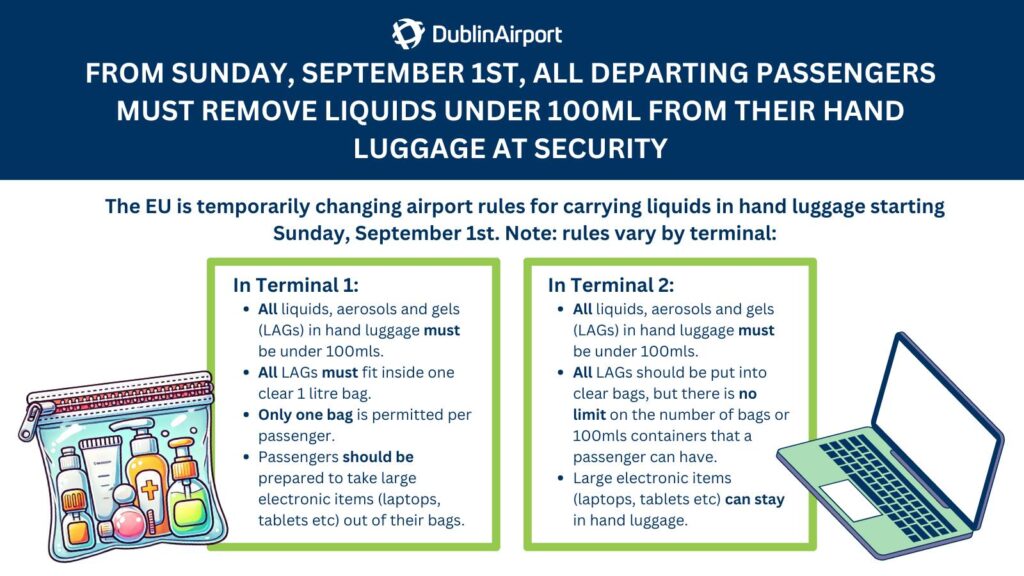Dublin Airport (DUB | EIDW) in Ireland will introduce temporary changes to its security screening procedures starting Sunday, 01 September 2024, in response to new European Union regulations regarding liquids, aerosols, and gels (LAGs) in hand luggage. The adjustments, which impact both Terminal 1 and Terminal 2, are part of a broader effort to enhance security measures across EU airports while the rollout of advanced C3 scanners continues.
Passengers departing from Dublin Airport should be aware that they will need to remove all LAGs from their hand luggage before undergoing security screening. All liquids must be in containers of 100ml or less. However, the specific procedures vary depending on the terminal.
In Terminal 1, passengers are required to place all liquids in a single, clear, 1-liter bag measuring 20cm x 20cm. Each passenger is allowed only one such bag, which must be visibly placed in the security tray. In addition, large electronic devices, such as laptops and tablets, must be removed from bags and placed in a separate tray for screening.
Terminal 2, which has progressed further in the implementation of the C3 scanner technology, offers slightly different guidelines. While liquids must still be under 100ml and placed in clear bags, there is no limit on the number of bags or 100ml containers that passengers can carry through security. Unlike in Terminal 1, passengers in Terminal 2 are not required to remove large electronic devices from their hand luggage.

“These changes, which apply to all airports in Ireland and Europe with C3 scanners, are being introduced at a time when the roll-out of new C3 scanners is ongoing at Dublin Airport. That roll-out is at different stages in Terminal 1 and Terminal 2, which means the guidance for passengers is slightly different depending on what terminal they are departing from. In Terminal 2, all of the security lanes in operation are now fitted with new C3 scanners, so all passengers are assured of using a C3 scanner. However, in Terminal 1, due to the age of the building, the roll-out is taking slightly longer, so it cannot be guaranteed whether a passenger will go through a lane with C3 scanners installed or the older technology. As previously communicated, the rollout of C3 scanners across both terminals is on track for completion by October 2025,” according to Dublin Airport Managing Director Gary McLean.
He added that all security lanes in Terminal 2 are now equipped with C3 scanners, ensuring that every passenger passing through the terminal will benefit from the enhanced technology. However, the rollout in Terminal 1 is progressing more slowly due to the building’s age, meaning that passengers may still encounter older screening technology in some lanes.
McLean emphasized the importance of passenger cooperation during this transition period.
Dublin Airport has committed to completing the installation of C3 scanners in both terminals by October 2025. In the meantime, passengers are encouraged to check the airport’s website and social media channels for the latest updates on security procedures.
While the temporary regulations apply to all airports in Ireland and the EU with C3 scanners, exceptions remain for baby food, medicines, and special dietary requirements, which may be carried in containers exceeding 100ml. These items must be presented separately during security screening.
Dublin Airport officials hope that the temporary restrictions will be lifted soon, once the new technology is fully operational and EU regulations are updated accordingly.
